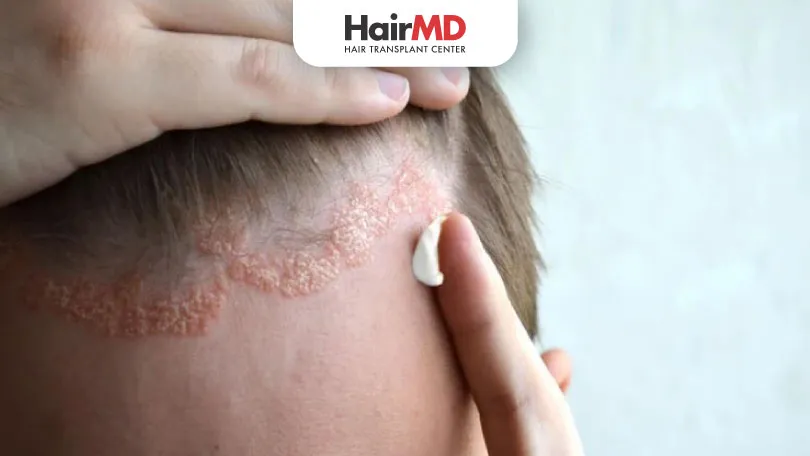24th Jan, 2024

What’s covered in the article?
- What is seborrheic dermatitis?
- Seborrheic Dermatitis Causes
- Seborrheic Dermatitis Symptoms
- Seborrheic Dermatitis vs Dandruff
- Best Treatment for Seborrheic Dermatitis on Scalp
- Conclusion
What is seborrheic dermatitis?
Seborrheic dermatitis is a skin condition characterized by redness and scaly patches on the scalp. It could also affect other skin regions which are oily, such as the chest, back, and face. This condition leads to dry, flaky skin of the scalp and may cause itching. It is not contagious, and is fairly common. Medications can be used to manage the symptoms. Here we will look at the causes and symptoms of seborrheic dermatitis and its treatment.
Seborrheic Dermatitis Causes
- Malassezia, a type of yeast present in everyone’s skin, grows excessively in some individuals, causing seborrheic dermatitis.
- A rise in the levels of androgens can lead to seborrheic dermatitis.
- An increase in lipid levels in the skin is another cause of this condition.
- It could result from inflammation.
- Having other skin conditions increases the risk of getting seborrheic dermatitis, and those with a family history of seborrheic dermatitis have a higher possibility of getting the same.
- Cold, dry weather can trigger seborrheic dermatitis.
- Using alcohol-based skin products can lead to seborrheic dermatitis.
- Oily skin is another factor causing this condition.
- Seborrheic dermatitis may be caused by stress.
Seborrheic Dermatitis Symptoms
The symptoms of seborrheic dermatitis include the following:
- Rashes (the rash is annular in a condition called pelatoid seborrheic dermatitis)
- Dryness of the scalp
- Flaky skin of the scalp and peeling
- Dandruff
- Redness of the scalp skin
- Itching
- Patches of greasy skin are covered with white or yellow scales
Seborrheic Dermatitis vs Dandruff
Dandruff leads to white, oily flakes on the scalp that cause itching. The condition worsens during winter or when the air is dry. Seborrheic dermatitis leads to dry, flaky skin that itches and is also characterized by white or yellow scales, inflammation, and redness on the affected skin. While dandruff and seborrheic dermatitis have very similar symptoms, there are some differences between the two conditions. Dandruff is found mainly on the scalp. Seborrheic dermatitis can spread to other regions like the face, ears, and chest. While dandruff mostly spans the years between puberty and the 20s and does not occur after the age of 50, seborrheic dermatitis mostly occurs during infanthood (cradle cap, a common condition among infants, is caused by seborrheic dermatitis) and adolescence.
Best Treatment for Seborrheic Dermatitis on Scalp
- Antifungal creams or gels help manage the symptoms of seborrheic dermatitis.
- Creams or shampoos that control inflammation can be used in treating seborrheic dermatitis. A corticosteroid may be prescribed to help ease the symptoms.
- Antifungal medications that can be taken orally, is another way to treat the symptoms of seborrheic dermatitis.
- Oiling the scalp can help remove scales from the hair.
- It is advisable to avoid using styling products that contain chemicals or hair products that contain alcohol.
- Keeping the scalp, eyelids, eyebrows, and facial hair clean, is important to manage the symptoms of seborrheic dermatitis.
- Metronidazole is effective against bacteria and thus proves to be effective in reducing the symptoms of seborrheic dermatitis.
- A combination of psoralen and light therapy may be used to treat seborrheic dermatitis.
Do You Know?
Nearly 250 Patients Visit HairMD
Everyday For Various Hair Concerns?
(Your journey to healthier and fuller hair starts here!)
Meet Our Dermatologists
Conclusion
Seborrheic dermatitis of the scalp can be a challenging condition, but with proper treatment and care, it is manageable. Identifying the right combination of medicated shampoos, topical treatments, and lifestyle adjustments can significantly improve symptoms and reduce flare-ups. Consulting a dermatologist for personalized advice is essential to effectively address the condition and maintain a healthy scalp. If you’re dealing with persistent dandruff or inflammation, don’t hesitate to seek professional help to regain control over your scalp health.
For expert advice on seborrheic dermatitis on scalp treatment, you should consult a dermatologist. He/she will guide you well about the seborrheic dermatitis permanent cure (whether it exists), as well as the causes and symptoms of the condition and how it is different from dandruff. If you are experiencing any of the symptoms given here, and wish to get your condition diagnosed, or if are already aware of your skin condition and are seeking the most effective seborrheic dermatitis scalp treatment, one of the best places to approach is HairMD. It is a hair transplant centre in Pune with a team of experienced dermatologists. Here you will get the correct diagnosis and treatment for seborrheic dermatitis and with the able guidance of the doctors here, you will be able to attain healthy hair.
Further Reading
Top Kitchen Ingredients to Boost Hair Growth
Discover the best kitchen ingredients for hair growth! Use coconut oil, onion juice, aloe vera & more to nourish your hair naturally and reduce hair fall.
How to Treat Alopecia Areata at Home: Natural Solutions for Hair Growth
Explore home remedies for alopecia areata to promote hair regrowth and boost confidence from home.
Redensyl vs. Minoxidil: Which is the Better For Hair Growth?
Discover the differences between Redensyl and Minoxidil for hair growth. Learn about their effectiveness, side effects, and which treatment might be better for you.
Biotin-Rich Foods for Natural Hair Growth
Know the best foods rich in biotin to help your hair to grow naturally stronger and healthier by experts from HairMD, Pune
Have thoughts? Please let us know
We are committed not only to treating you, but also educating you.











